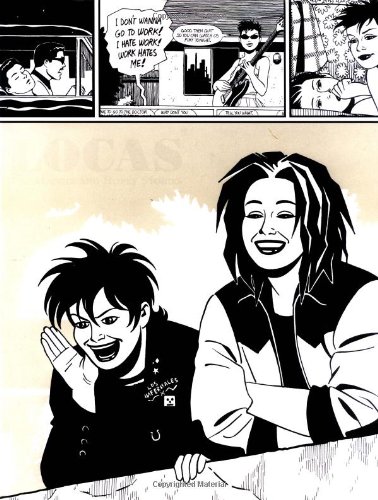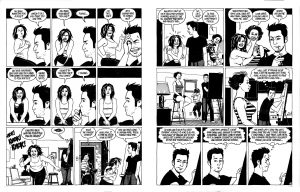Review by Woodrow Phoenix
Locas is a massive 700 page slab of a book, assembling in one big hardcover volume the strips that appeared in ten or twenty-page chunks dispersed through two decades and fifty-plus issues of the magazine Love and Rockets. Stories from Jaime Hernandez and his brother Gilbert alternated and intermingled in L&R to form a powerfully idiosyncratic world, rejecting a lot of what was current in the American comics scene and going their own way. Jaime wrote and drew stories about a variety of protagonists but his main focus was and is Maggie Chascarillo, a complicated but open-hearted Mexican-American woman living in a suburb of Los Angeles, California and immersed in several overlapping subcultures. Locas tracks her life from her teenage punk 1980s to her forty-something 2000s, and her on-again, off-again love affair with the always enigmatic and unpredictable Hopey Glass. It moves through an early beguiling mix of science fictional rocket ships, dinosaurs and robots alternating with female wrestling and punk gigs in L.A. dive bars, into superheroes, romance serials and thrillers to arrive at an eventually genre-free total naturalism rarely seen in comics and never done as well as this.
Hernandez wears his command of every facet of sequential narrative so lightly that while you’re seduced by his gorgeous drawings, you don’t notice how densely and subtly told his stories are, and how inhumanly patient he is in building those stories to the point where he can devastate you with a single page of six frames. A simple summing-up of plotlines can’t give you the breadth of the vision on display in this volume, the joy of Locas is in the experiencing of a situation as Maggie lives it, and then what happens as Hernandez retells that episode from a different viewpoint to give the same story a radically different conclusion that multiplies all the emotional and textural impact in incredible ways. You thought you were seeing X? Nope, you were really seeing Y. While Hernandez is a fearless risk-taker, stretching every possible boundary with his story-telling, he keeps his layouts elegantly simple and rarely deviates from a six or eight-panel grid. His focus is entirely on what happens within the panel, not with pushing the page-layout around. His drawing accentuates personality first, in acutely observed body language. So much information about who people are, what they want and how they feel about each other is conveyed entirely visually. No two characters stand the same way or wear their clothes the same even when they are identically dressed. Somehow without using colour or even halftones he can use light and shadow to evoke times of day, emotional states, weather and even temperature with an unerring, totally convincing pen and brushline.
There are so many riches buried in this book collection it will take you years of re-readings to discover them all. Maggie Chascarillo, her friends and lovers, Hopey, Penny, Izzy, Speedy, Danita, Ray, Doyle and Rena live and breathe with a vitality and credibility rarely seen in any medium. Locas is an essential social document and an utterly masterful treasure from one of the greatest creators working in the comics medium.
While huge and definitive, Locas is not an exhaustive collection of every Jaime Hernandez story from Love and Rockets. Strips mainly featuring other characters aren’t reprinted here, but can be found in the smaller paperback collections Maggie The Mechanic, The Girl from H.O.P.P.E.R.S., Perla la Loca and Penny Century. There is a companion volume that covers Maggie’s progress through her thirties and forties, Locas II: Maggie, Hopey and Ray.





